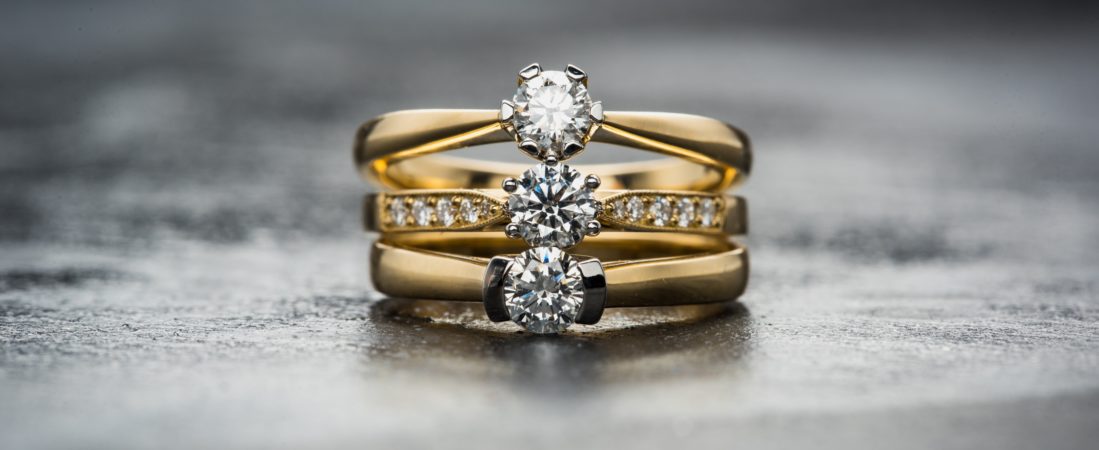A Diamond is Forever – The History of Diamonds
It’s long been said that “diamonds are a girl’s best friend”, but when did diamonds become popular?
Prehistoric stones
Some of the earliest records involving the discovery of diamonds arise in India in the 4th century. A majority of these stones were transported along the Silk Road, and are believed to have been formed around 900 million years ago. The oldest deposits ever found, however, are the Hadean diamonds of Jack Hills, Western Australia, which formed within detrital zircons and are believed to be over 4 billion years old. These diamonds developed as tiny flakes, not full stones, and are still being used by scientists to understand more about the Earth’s core and the formation of the oceans.
Diamonds as tools
The diamond remains to be the most popular precious gemstone for engagement rings in the modern market, but it wasn’t always so.
Featuring diamonds in jewellery is a relatively recent use of the stone. In the earliest periods following their discovery, diamonds were predominantly used for their key defining property – their strength. With a tough carbon structure, diamonds are incredibly hard and durable. The tools and technology used for shaping them are a more recent development; originally the diamond itself would be used as a tool.
The discovery of diamond traces amongst collections of Ancient Chinese tools dating back to 2500BC solidifies this theory. Amid the tools and traces of diamond, traces of some corundum-based minerals, including rubies and sapphires, have also been discovered, providing evidence that, at least in some early civilisations, these precious stones were valued more for their hard-wearing properties and strength than their beauty.
Diamonds remain to be used in tools today, however these diamonds are now referred to as “industrial diamonds”. Which stones are utilised as tools and which are incorporated into jewellery is determined not only by the appearance of the stones, but also by the demand in the jewellery market.
Diamonds as adornments
The earliest evidence of diamonds being used as adornments as opposed to tools has been attributed to Ancient India, where diamonds were used to decorate both people and statues. When studying the manuscripts of the Mauryan Dynasty (322BC – 185BC), scholars discovered a mention of the precious stones being incorporated into Indian culture – rulers would wear diamond rings to symbolise their wealth and societal rank, and in the Hindu faith, diamonds would be placed on the eyes of the statues of the deities.
The engagement ring
The concept of the engagement ring itself has an intriguing history, however one of the first noted uses of diamonds featuring in an engagement ring dates back to 1477, when Archduke Maximilian of Austria proposed to Mary of Burgundy with a ring which had been set with thin, flat pieces of diamond, all arranged in the shape of an ‘M’. This is known to be the first commissioned diamond ring on record, and it sparked a trend for the stone amongst European aristocracy and nobility.
The popularity of diamond engagement rings later resurged in the Victorian era, when the age saw the development of ornate engagement ring designs which combined diamonds with other gemstones and precious metals. Often arranged in the shape of a flower, these rings were referred to as “posey rings”, and they set the basis for Edwardian ring designs.
A Diamond is Forever – the campaign that changed everything
From 1919 onwards, the market for diamond rings was in a steady decline, noting a preference for intricate metal work over the inclusion of gemstones into ring designs. This was the case until, in 1938, De Beers enlisted the help of one of New York’s top ad agencies, N.W. Ayer.
The power of N.W. Ayer’s campaign could not have been foreseen, however it remains to be one of the most effective and impactful ad campaigns ever devised. In the first phase, the agency depicted Hollywood’s elite adorned with diamonds and had leading fashion designers promote the stone as an emerging trend. In the first three years, diamond ring sales grew by over 50%.
A few years later, in 1947, the campaign delivered it’s second phase when copywriter France Gerety dreamt up the slogan “A Diamond is Forever”. Elegant and efficient, Gerety’s slogan effectively rewrote the connotations of what a diamond could symbolise, and the stone quickly became associated with betrothal and eternal love.
In the following 20 years, 80% of the engagement rings within the American market had diamonds as a key feature. More recently, the first online app for purchasing diamond rings was launched in 2010, and a survey of American women in 2015 saw almost 70% of them say that they would prefer to have a gemstone in their engagement ring than not. The favoured gemstone? The diamond.
Are you considering releasing some of your diamond assets? Here at We Buy Any Diamonds, our team of experts have been in the business for over 30 years. With an unrivalled level of industry experience, we aim to provide the best possible return on your investment. Get in touch for more information about our process, or click here to sell your diamond today.



